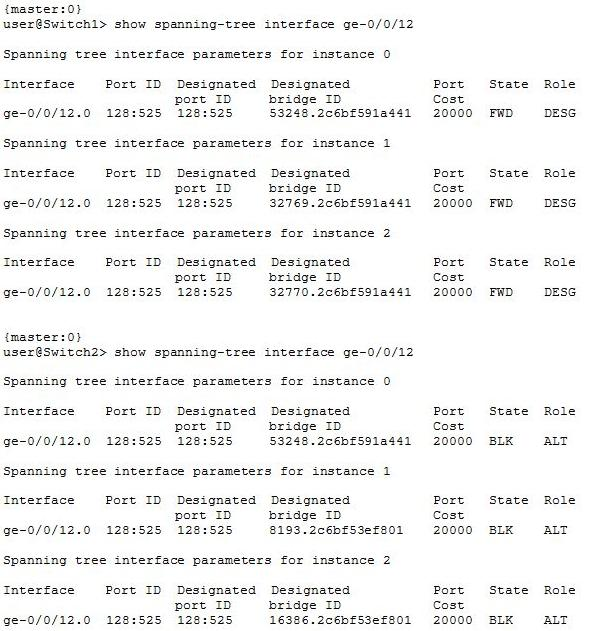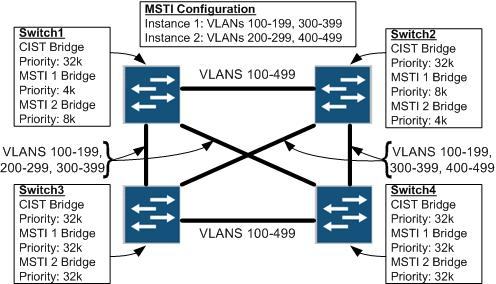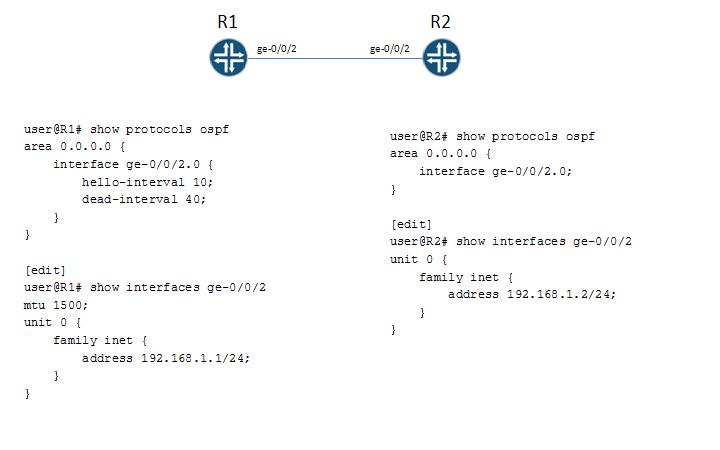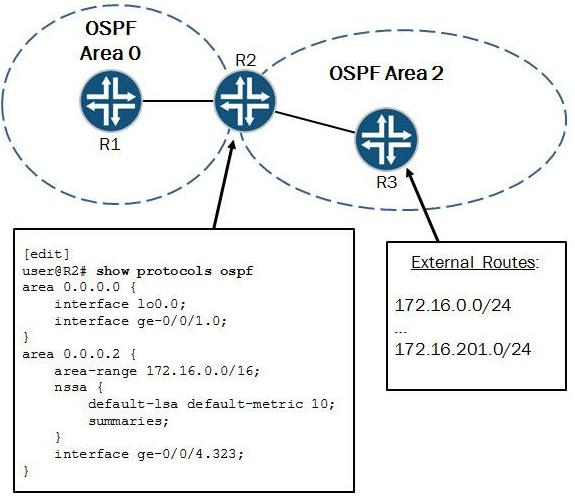Enterprise Routing and Switching Support, Professional (JNCSP- ENT) v6.1
Question 1
-- Exhibit --
Jun 12 02:56:06 R1 rpd[60735]: RPD_OSPF_NBRDOWN: OSPF neighbor 10.50.10.25
(realm ospf-v2 fe-0/0/4.0 area 0.0.0.0) state changed from Full to Init due to 1WayRcvd
(event reason: neighbor is in one-way mode)
Jun 12 02:59:36 R1 rpd[60735]: RPD_OSPF_NBRUP: OSPF neighbor 10.50.10.25 (realm ospf-v2 fe-0/0/4.0 area 0.0.0.0) state changed from Init to ExStart due to 2WayRcvd (event reason: neighbor detected this router)
Jun 12 02:59:36 R1 rpd[60735]: RPD_OSPF_NBRUP: OSPF neighbor 10.50.10.25 (realm ospf-v2 fe-0/0/4.0 area 0.0.0.0) state changed from Exchange to Full due to
ExchangeDone (event reason: DBD exchange of slave completed)
-- Exhibit --
Click the Exhibit button.
You notice that there is a problem with the OSPF adjacency between two routers, R1 and
R2. The relevant system logs from R1 are shown in the exhibit.
What would cause this behavior?
- A. R2 was dropping R1's OSPF hello packets.
- B. R1 was dropping R2's OSPF hello packets.
- C. R1's interface went down and came back up.
- D. There is an OSPF hello timer mismatch between the two routers.
Answer : A
Question 2
Interface ge-0/0/12 on Switch1 is connected to ge-0/0/12 on Switch2. You have configured both Switch1 and Switch2 to run MSTP. You see the CLI output shown in the exhibit.

What would cause this output?
- A. Switch1 and Switch2 are configured with different autonomous systems.
- B. Switch1 and Switch2 are configured with different bridge priorities.
- C. Switch1 and Switch2 are configured with different names for their VLANs.
- D. Switch1 and Switch2 are configured with different revision levels.
Answer : D
Question 3
-- Exhibit

-- Exhibit --
Click the Exhibit button.
The exhibit shows a small switched network, some details about the MSTP configuration in the network, and the VLANs that are trunked over each link. When Switch2 reboots, users in VLAN 400 on Switch3 report that they lose connectivity to resources in VLAN 400 on
Switch4.
What is the cause of this problem?
- A. There are mismatched bridge priorities.
- B. There is a mismatched MSTP configuration name.
- C. VLAN 400 is not trunked between Switch1 and Switch3.
- D. VLAN 400 is trunked between Switch3 and Switch4.
Answer : C
Question 4
-- Exhibit --
policy-options {
policy-statement accept-static {
from protocol static;
then accept;
-- Exhibit --
Click the Exhibit button.
The policy shown in the exhibit is deployed on a router and used as the only BGP export policy. The router is sending only one BGP route to its peers. However, when you run the
CLI command test policy accept-static 0.0.0.0/0, the policy matches thousands of routes.
Which statement explains this discrepancy?
- A. All policies have an implicit then accept final term.
- B. The default policy for BGP is to reject all routes.
- C. The default policy for the test policy command is to accept all routes.
- D. The test policy command always shows all routes, regardless of whether they match the policy, when you use the 0.0.0.0/0 argument.
Answer : C
Question 5
-- Exhibit --
user@switch>show dot1x interface ge-0/0/1 detail
ge-0/0/1.0
Role: Authenticator -
Administrative state: Auto -
Supplicant mode: Multiple -
Number of retries: 3 -
Quiet perioD. 60 seconds -
Transmit perioD. 30 seconds -
Mac Radius: Enabled -
Mac Radius Restrict: Enabled -
Reauthentication: Disabled -
Configured Reauthentication interval: 3600 seconds
Supplicant timeout: 30 seconds -
Server timeout: 30 seconds -
Maximum EAPOL requests: 2 -
Guest VLAN member:
Number of connected supplicants: 0
-- Exhibit --
Click the Exhibit button.
You are asked to troubleshoot an access control issue on your EX Series switch. The user connecting through port ge-0/0/1 indicates that their 802.1X supplicant is failing authentication and they are not able to connect to the network.
Referring to the exhibit, what is causing the 802.1X supplicant to fail?
- A. The supplicant mode is defined as multiple.
- B. The MAC restrict option is configured.
- C. The supplicant timeout value is set too low.
- D. The reauthentication interval is set too high.
Answer : B
Question 6
-- Exhibit --
user@R1> show class-of-service interface ge-0/0/0
Physical interface: ge-0/0/0, Index: 134
Queues supporteD. 8, Queues in use: 4
Scheduler map: , Index: 2 -
Congestion-notification: Disabled
Logical interface: ge-0/0/0.0, Index: 69
Object Name Type Index -
Classifier ipprec-compatibility ip 13
-- Exhibit --
Click the Exhibit button.
You are sending traffic to the ge-0/0/0 interface on R1 with the expedited forwarding (101)
IP precedence bits. However, the counters on the router show that it is not processing any traffic in the expedited forwarding queue.
Referring to the exhibit, what is causing the problem?
- A. The classifier does not contain a mapping for this precedence value.
- B. The classifier is assigning the traffic a high loss priority.
- C. The classifier is assigning the traffic to the best-effort forwarding class.
- D. The classifier is dropping the traffic.
Answer : C
Question 7
-- Exhibit

-- Exhibit --
Click the Exhibit button.
You are troubleshooting an OSPF adjacency problem between R1 and R2.
Referring to the exhibit, what is causing this OSPF adjacency problem?
- A. There is a hello interval mismatch.
- B. There is a dead interval mismatch.
- C. There is an MTU mismatch.
- D. There is an LSA refresh timer mismatch.
Answer : C
Question 8
Your Layer 2 network uses VLAN IDs 100 through 400 and you are required to load- balance these VLANs between two different root bridges. You are currently using the default RSTP settings and notice that all VLANs are using the same root bridge.
How do you ensure the VLANs are load-balanced between two root bridges?
- A. Configure MSTP with two MSTI regions and split the VLAN range between them.
- B. Configure VSTP with two VLAN groups and split the VLAN range between them.
- C. Configure two RSTP instances and split the VLAN range between them.
- D. Configure STP and RSTP and split the VLAN range between them.
Answer : A
Question 9
-- Exhibit --
user@router# show class-of-service
classifiers {
inet-precedence ipp-test {
import default;
forwarding-class best-effort {
loss-priority low code-points be;
forwarding-class expedited-forwarding {
loss-priority low code-points af21;
forwarding-class assured-forwarding {
loss-priority low code-points af11;
forwarding-class network-control {
loss-priority low code-points nc1;
interfaces {
ge-* {
scheduler-map map-test;
unit * {
classifiers {
inet-precedence ipp-test;
}
rewrite-rules {
inet-precedence ipp-rw-test;
inet-precedence default;
...
rewrite-rules {
inet-precedence ipp-rw-test {
forwarding-class best-effort {
loss-priority low code-point be;
loss-priority high code-point af21;
forwarding-class expedited-forwarding {
loss-priority high code-point af21;
loss-priority low code-point be;
forwarding-class assured-forwarding {
loss-priority low code-point af11;
loss-priority high code-point af11;
forwarding-class network-control {
loss-priority low code-point nc1;
loss-priority high code-point nc1;
user@router> show class-of-service
...
Code point type: inet-precedence
Alias Bit pattern -
af11 001
af21 010
af31 011
af41 100
be 000
cs6 110
cs7 111
ef 101
nc1 110
nc2 111
-- Exhibit --
Click the Exhibit button.
Traffic with the IP precedence value af21 ingresses the router and should be rewritten with the same value as it egresses; however, this traffic is rewritten to a different value.
Referring to the exhibit, what is the source of this problem?
- A. The BA classifier is assigning the traffic to the best-effort queue with a high loss priority.
- B. The BA classifier is assigning the traffic to the best-effort queue with a low loss priority.
- C. The BA classifier is assigning the traffic to the expedited forwarding queue with a high loss priority.
- D. The BA classifier is assigning the traffic to the expedited forwarding queue with a low loss priority.
Answer : D
Question 10
You are troubleshooting a problem where external routes are not being summarized into the OSPF backbone.

Referring to the exhibit, what needs to be done to resolve this problem?
- A. The area-range parameter needs to be under Area 0.
- B. The area-range parameter needs to be under the nssa hierarchy.
- C. The summaries parameter needs to be removed under the/issa hierarchy.
- D. The area-range parameter must include the override-metric parameter.
Answer : B
Question 11
-- Exhibit --
(MSTI 2 regional root: 16386.2c:6b:f5:3e:f8:01)
{master:0}
user@switch> show spanning-tree interface
Spanning tree interface parameters for instance 0
Interface Port ID Designated Designated Port State Role
port ID bridge ID Cost
ge-0/0/6.0 128:519 128:519 16384.80711fbc 20000 BLK ALT
ge-0/0/9.0 128:522 128:522 53248.2c6bf591a441 20000 FWD DESG
ge-0/0/10.0 128:523 128:523 8192.80711fbe8110 20000 FWD ROOT
ge-0/0/12.0 128:525 128:525 49152.2c6bf53ef801 20000 BLK ALT
[...]
-- Exhibit --
Click the Exhibit button.
While troubleshooting an MSTP operation in your network, you see the output shown in the exhibit on one of your switches. You know that the MSTI 2 regional root bridge ID is
16386.2c:6b:f5:3e:f8:01.
Which port is attached to the root bridge of MSTI 2?
- A. ge-0/0/6
- B. ge-0/0/9
- C. ge-0/0/10
- D. ge-0/0/12
Answer : D
Question 12
An end user on interface ge-0/0/1.0 is trying to receive a multicast stream for 232.0.0.1 sourced from but is not receiving it. You use the show igmp group command and do not see this group in the list. You enable traceoptions for IGMP and find the following IGMPv3 report from the end user's host:
Jun 10 13:11:03.577641 RCV IGMP V3 Report len 16 from 192.168.1.13 intf ge-0/0/1.0
Jun 10 13:11:03.577984 Records 1
Jun 10 13:11:03.578027 Group 232.0.0.1, type IS_EX, aux_len 0, sources 0
Which configuration change is required to allow the group to be added in the router?
- A. set routing-options multicast ssm-groups 232.0.0.1/32
- B. set routing-options multicast asm-override-ssm
- C. set protocols igmp interface ge-0/0/1.0 promiscuous-mode
- D. set protocols igmp interface ge-0/0/1.0 group-limit 2
Answer : B
Question 13
-- Exhibit --
user@switch# show vlans
ws {
vlan-id 23;
interface {
ge-0/0/12.0;
ge-0/0/6.0;
dot1q-tunneling;
no-mac-learning;
-- Exhibit --
Click the Exhibit button.
Referring to the exhibit, an administrator notices that all traffic is flooded out of all the ports in VLAN ws.
What would cause this problem?
- A. no-mac-learning is enabled on the interface.
- B. Spanning tree is disabled.
- C. dot1q-tunneling is enabled on the VLAN.
- D. Unicast destinations are flooded out of all ports.
Answer : A
Question 14
-- Exhibit --
user@R1> show ospf neighbor
Address Interface State ID Pri Dead
10.222.0.2 ge-0/0/1.0 Init 10.222.1.2 128 32
user@R1> show ospf interface detail
Interface State Area DR ID BDR ID Nbrs
ge-0/0/1.0 DR 0.0.0.0 10.222.1.1 0.0.0.0 1
Type: LAN, Address: 10.222.0.1, Mask: 255.255.255.252, MTU: 1500, Cost: 1
DR addr: 10.222.0.1, Priority: 128
Adj count: 0 -
Hello: 10, DeaD. 40, ReXmit: 5, Not Stub
Auth type: MD5, Active key ID. 10, Start time: 1970 Jan 1 00:00:00 UTC
Protection type: None -
Topology default (ID 0) -> Cost: 1
lo0.0 DR 0.0.0.0 10.222.1.1 0.0.0.0 0
Type: LAN, Address: 10.222.1.1, Mask: 255.255.255.255, MTU: 65535, Cost: 0
DR addr: 10.222.1.1, Priority: 128
Adj count: 0 -
Hello: 10, DeaD. 40, ReXmit: 5, Not Stub
Auth type: None -
Protection type: None -
Topology default (ID 0) -> Cost: 0
user@R2> show ospf neighbor
user@R2> show ospf interface detail
Interface State Area DR ID BDR ID Nbrs
ge-0/0/1.0 PtToPt 0.0.0.0 0.0.0.0 0.0.0.0 0
Type: P2P, Address: 10.222.0.2, Mask: 255.255.255.252, MTU: 1500, Cost: 1
Adj count: 0 -
Hello: 10, DeaD. 40, ReXmit: 5, Not Stub
Auth type: MD5, Active key ID. 10, Start time: 1970 Jan 1 00:00:00 UTC
Protection type: None -
Topology default (ID 0) -> Cost: 1
lo0.0 DR 0.0.0.0 10.222.1.2 0.0.0.0 0
Type: LAN, Address: 10.222.1.2, Mask: 255.255.255.255, MTU: 65535, Cost: 0
DR addr: 10.222.1.2, Priority: 128
Adj count: 0 -
Hello: 10, DeaD. 40, ReXmit: 5, Not Stub
Auth type: None -
Protection type: None -
Topology default (ID 0) -> Cost: 0
-- Exhibit --
Click the Exhibit button.
You are trying to establish an OSPF adjacency between R1 and R2, but the adjacency does not establish.
Referring to the exhibit, what is causing the adjacency to fail?
- A. The MD5 key ID values are mismatched between R1 and R2.
- B. R1 has both family inet and family iso configured on the link toward R2.
- C. The IP subnet mask is mismatched between R1 and R2.
- D. The interface type is mismatched between R1 and R2.
Answer : D
Question 15
-- Exhibit --
user@router# run show log ospf-test
...
Jun 10 22:35:38.598494 OSPF sent Hello 10.100.0.1 -> 224.0.0.5 (ge-1/0/3.1000 IFL 77 area 0.0.0.0)
Jun 10 22:35:38.598520 Version 2, length 44, ID 10.100.1.2, area 0.0.0.0
Jun 10 22:35:38.598543 mask 255.255.255.252, hello_ivl 10, opts 0x2, prio 128
Jun 10 22:35:38.598564 dead_ivl 32, DR 10.100.0.1, BDR 0.0.0.0
Jun 10 22:35:41.522956 OSPF periodic xmit from 10.200.26.1 to 224.0.0.5 (IFL
2684276196 area 0.0.0.1)
Jun 10 22:35:42.798220 OSPF rcvd Hello 10.100.0.2 -> 224.0.0.5 (ge-1/0/3.1000 IFL 77 area 0.0.0.0)
Jun 10 22:35:42.798311 Version 2, length 48, ID 10.100.1.1, area 0.0.0.0
Jun 10 22:35:42.798334 checksum 0x0, authtype 0
Jun 10 22:35:42.798356 mask 255.255.255.252, hello_ivl 10, opts 0x2, prio 128
Jun 10 22:35:42.798377 dead_ivl 40, DR 10.100.0.2, BDR 10.100.0.1
Jun 10 22:35:45.189034 OSPF rcvd Hello 10.100.0.2 -> 224.0.0.5 (ge-1/0/3.1000 IFL 77 area 0.0.0.0)
Jun 10 22:35:45.189097 Version 2, length 44, ID 10.100.1.1, area 0.0.0.0
Jun 10 22:35:45.189118 checksum 0x0, authtype 0
Jun 10 22:35:45.189140 mask 255.255.255.252, hello_ivl 10, opts 0x2, prio 128
Jun 10 22:35:45.189162 dead_ivl 40, DR 10.100.0.2, BDR 0.0.0.0
Jun 10 22:35:45.196969 OSPF DR is 10.100.1.2, BDR is 0.0.0.0
Jun 10 22:35:45.197050 OSPF sent Hello 10.200.26.1 -> 224.0.0.5 (ge-1/0/0.0 IFL 69 area
0.0.0.1)
Jun 10 22:35:45.197076 Version 2, length 44, ID 10.100.1.2, area 0.0.0.1
Jun 10 22:35:45.197098 mask 255.255.255.252, hello_ivl 10, opts 0x2, prio 128
Jun 10 22:35:45.197119 dead_ivl 40, DR 10.200.26.1, BDR 0.0.0.0
Jun 10 22:35:46.746900 OSPF periodic xmit from 10.100.0.1 to 224.0.0.5 (IFL 2684276196 area 0.0.0.0)
-- Exhibit --
Click the Exhibit button.
Referring to the exhibit, what is preventing the OSPF neighborship with two directly connected routers using interface ge-1/0/3 from reaching the full state?
- A. dead interval mismatch
- B. authentication type mismatch
- C. subnet mismatch
- D. hello interval mismatch
Answer : A